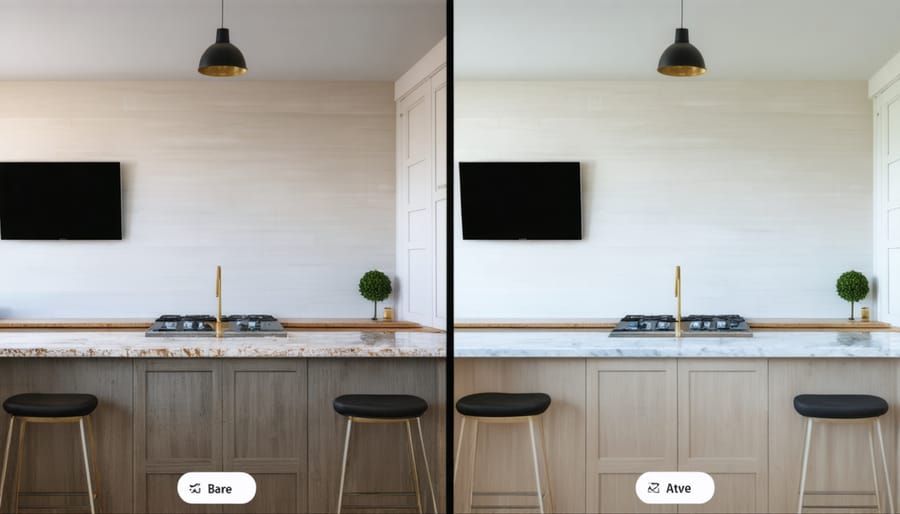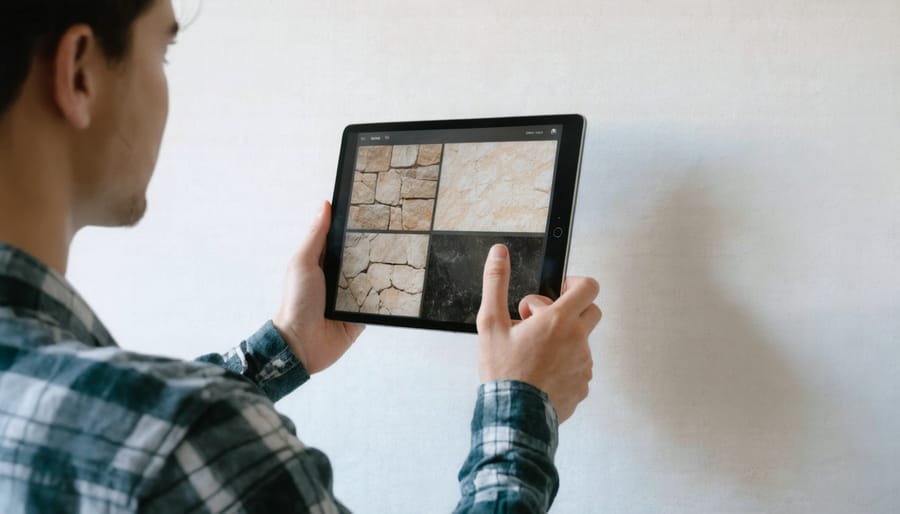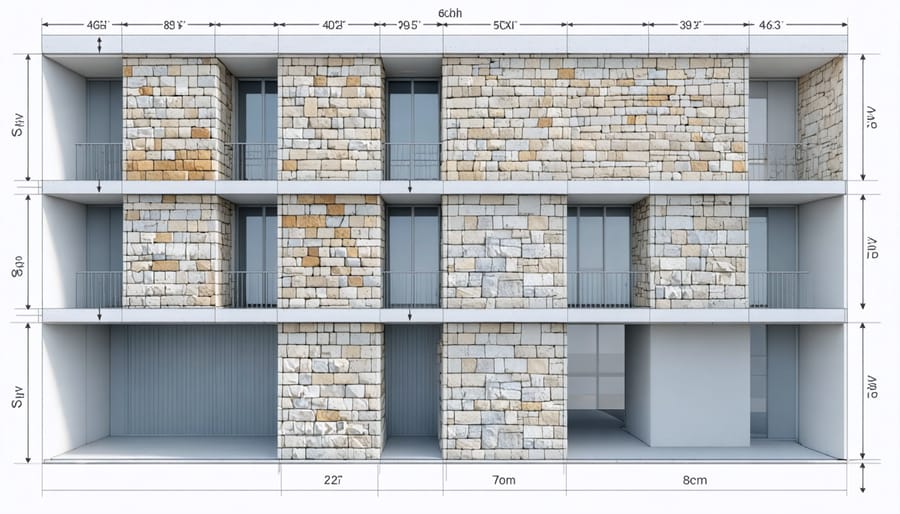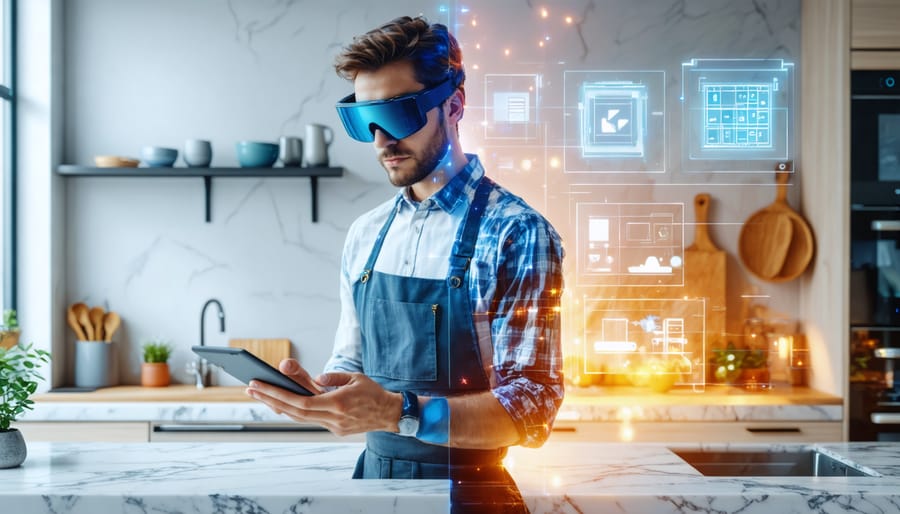Step into the future of stone design with augmented reality studios – powerful digital environments where virtual and physical worlds merge to revolutionize how we visualize, select, and customize natural stone surfaces. This groundbreaking technology transforms the traditional stone selection process, enabling designers, architects, and homeowners to project hyper-realistic stone patterns onto actual spaces before making final decisions.
Unlike conventional showroom experiences, AR studios eliminate the guesswork by overlaying digital stone textures in real-time, accurately representing how marble, granite, or quartzite will appear in specific lighting conditions and spatial configurations. Clients can instantly swap between hundreds of stone varieties, adjust pattern alignments, and explore different finishes – all while walking through their actual space or viewing remote presentations.
Industry leaders are rapidly adopting these immersive visualization tools, recognizing their potential to reduce costly mistakes, streamline the decision-making process, and deliver unprecedented client satisfaction. With photorealistic rendering capabilities and precise dimensional accuracy, augmented reality studios are reshaping how we interact with and specify natural stone materials.
What is an Augmented Reality Studio for Stone Design?
Core Components of an AR Stone Design Studio
A well-equipped AR stone design studio requires several essential components to deliver immersive and accurate visualization experiences. The foundation starts with high-performance computers capable of running sophisticated 3D visualization technology and AR applications. These workstations should feature powerful graphics cards and ample RAM to handle complex stone textures and patterns seamlessly.
The AR hardware setup typically includes advanced cameras and depth sensors for accurate spatial mapping, along with AR headsets or smart devices for viewing the augmented content. Motion tracking systems ensure precise alignment of virtual stone elements with physical spaces.
On the software side, professional AR design studios utilize specialized applications for stone pattern recognition, texture mapping, and real-time rendering. These tools often integrate with industry-standard CAD software and material databases containing detailed information about different stone types, finishes, and characteristics.
Additional essential tools include proper lighting equipment for accurate color representation, calibration tools for maintaining consistent AR experiences, and secure data storage systems for managing large libraries of stone textures and project files.
How AR Technology Renders Stone Patterns
AR technology creates lifelike stone pattern visualizations through a sophisticated combination of computer vision and real-time rendering. The process begins with high-resolution scanning of actual stone surfaces, capturing intricate details like veining, color variations, and texture. These scans are then processed into detailed digital textures that preserve the natural characteristics of the stone.
When users activate the AR application, their device’s camera identifies the target space using spatial mapping technology. The software analyzes the environment’s lighting conditions, surfaces, and dimensions to determine how the virtual stone pattern should appear. Advanced algorithms then render the stone texture in real-time, adjusting for perspective, shadows, and reflections to create a realistic representation.
The technology also accounts for different finishing options, allowing users to switch between polished, honed, or brushed surfaces instantly. Modern AR platforms can even simulate how natural light will interact with the stone throughout the day, providing a comprehensive preview of how the material will look in actual installation conditions.
Through continuous improvements in processing power and rendering capabilities, today’s AR applications can display stone patterns with near-photorealistic quality, making them invaluable tools for design visualization.


Benefits of Using AR Studio for Stone Projects
Cost and Time Savings
Implementing augmented reality in stone design studios delivers significant cost and time benefits for both professionals and clients. By visualizing stone patterns and layouts virtually before physical installation, AR technology dramatically reduces material waste and prevents costly mistakes in custom stone fabrication.
Traditional stone selection often requires multiple sample orders and site visits, leading to extended project timelines and increased expenses. AR studios eliminate these inefficiencies by allowing instant visualization of different stone varieties in the intended space. Clients can quickly evaluate multiple options, making informed decisions without the need for physical samples or repeated showroom visits.
The technology excels at reducing stone waste by enabling precise material calculations and optimal layout planning before cutting begins. Design teams can identify potential issues early in the process, adjusting plans virtually rather than discovering problems during installation. This proactive approach typically results in 15-20% material savings and significantly reduced installation time.
For businesses, AR studios streamline the client approval process, often reducing decision-making time from weeks to days. The technology also minimizes the need for physical inventory, reducing warehouse costs and storage requirements while still offering clients an extensive selection of stone options to choose from.
Enhanced Client Communication
Augmented reality studios revolutionize how professionals communicate design concepts to clients, particularly in natural stone projects where visualization can be challenging. By overlaying virtual stone selections onto real spaces, clients can instantly understand how different materials will look in their environment, eliminating the guesswork that often leads to project revisions and disappointment.
This enhanced visualization capability significantly improves client confidence in decision-making. Rather than relying on small sample pieces or imagination, clients can see full-scale representations of stone patterns, veining, and color variations in their actual space. They can explore different stone options, compare alternatives, and make informed decisions based on realistic previews.
The technology also facilitates more productive discussions about design details. Architects and designers can instantly demonstrate how different stone layouts, patterns, or finishing techniques will affect the final appearance. This real-time visualization capability helps prevent misunderstandings and reduces the need for costly modifications during installation.
Moreover, AR studios enable remote collaboration, allowing clients to participate in design reviews from anywhere. This flexibility streamlines the approval process and keeps projects moving forward efficiently. Clients can share their virtual designs with stakeholders, gathering feedback and building consensus before committing to material purchases or beginning installation work.
By providing this level of clarity and interaction, AR studios significantly improve client satisfaction and project outcomes while reducing the likelihood of costly changes during implementation.
Real-World Applications
Kitchen Countertop Visualization
Imagine standing in your current kitchen and instantly visualizing different countertop materials through your smartphone or tablet. AR technology makes this possible by overlaying virtual stone patterns onto your existing surfaces in real-time. Users can explore various granite, marble, and quartzite options, seeing exactly how each material would look in their space.
The AR visualization tool accounts for lighting conditions, allowing you to see how natural and artificial light interacts with different stone finishes throughout the day. You can switch between polished, honed, and leathered textures with a simple tap, comparing how each finish impacts the overall aesthetic of your kitchen.
What makes this technology particularly valuable is its ability to display accurate stone patterns and veining at scale. When selecting a marble countertop, for instance, you can see precisely how the veining will flow across your specific counter dimensions and around corners. The tool even allows you to visualize different edge profiles and thickness options, providing a comprehensive preview of your finished countertop design.
This technology eliminates much of the guesswork from the selection process, helping homeowners and designers make more confident decisions about their stone choices.
Exterior Facade Planning
Augmented reality has revolutionized the way architects and designers approach exterior facade planning, particularly in large-scale stone applications. By leveraging AR technology, professionals can now visualize entire building facades with different stone patterns, textures, and arrangements before any physical installation begins. This capability, combined with other modern stone masonry technologies, allows for unprecedented precision in planning and execution.
Using AR studio applications, designers can overlay virtual stone patterns onto existing building surfaces through tablet devices or AR glasses. This enables real-time visualization of how different stone types will appear under various lighting conditions and viewing angles. The technology also assists in calculating material quantities, identifying potential installation challenges, and optimizing stone panel layouts for minimal waste.
Particularly valuable for historic restoration projects, AR helps architects ensure new stone elements seamlessly integrate with existing facades. The technology can match patterns, analyze weathering effects, and predict how new stone installations will age alongside original materials. This level of detailed planning significantly reduces costly mistakes and ensures stunning architectural outcomes that stand the test of time.

Getting Started with AR Stone Design
Getting started with AR stone design is simpler than you might think. Begin by downloading a reputable AR design application specifically developed for natural stone visualization. Popular options include Stone AR Studio and Virtual Stone Designer, which offer comprehensive libraries of stone materials and patterns.
First, ensure your space is well-lit and clear of obstacles. The AR application will need to scan your room to create an accurate digital canvas. Using your device’s camera, slowly pan across the area where you plan to implement stone features. This creates a digital mesh that serves as the foundation for your virtual design.
Next, select your desired stone material from the application’s library. You can filter options by type (marble, granite, quartzite), color, pattern, and finish. Position the virtual stone in your space by tapping the screen where you want it to appear. Most apps allow you to adjust dimensions, rotation, and placement with simple touch gestures.
For more complex projects, take advantage of advanced features like measurements and material calculations. These tools help estimate the amount of stone needed and can prevent costly ordering mistakes. Many applications also offer the ability to save multiple design variations, making it easier to compare different stone options in the same space.
Remember to view your design from multiple angles and in different lighting conditions. What looks perfect from one perspective might reveal issues from another. Most AR applications allow you to capture screenshots or create virtual walkthrough videos, which are invaluable when sharing designs with contractors or seeking input from design professionals.
Don’t hesitate to experiment with different combinations and patterns. The beauty of AR technology is that you can try countless options without any physical installation or commitment.
Augmented reality studios have revolutionized the natural stone industry by bridging the gap between imagination and reality. By enabling designers, architects, and homeowners to visualize stone applications in real-time, these technologies have dramatically improved decision-making confidence and reduced costly mistakes in stone selection and installation.
The impact extends beyond mere visualization. AR studios have streamlined the entire design process, from initial concept to final implementation, making it more efficient and cost-effective. This technology has also opened new possibilities for creative experimentation with different stone varieties, patterns, and layouts without the physical limitations of traditional sampling methods.
Looking ahead, the future of AR in stone design appears incredibly promising. As technology continues to advance, we can expect even more sophisticated features, including enhanced material rendering, improved texture mapping, and integration with building information modeling (BIM) systems. The growing accessibility of AR tools will likely lead to wider adoption across the industry, making virtual stone visualization a standard practice rather than a luxury.
For the natural stone industry, AR studios represent not just a technological advancement, but a fundamental shift in how we approach design and client communication. This transformation will continue to shape the future of stone design, making it more accessible, efficient, and innovative than ever before.










